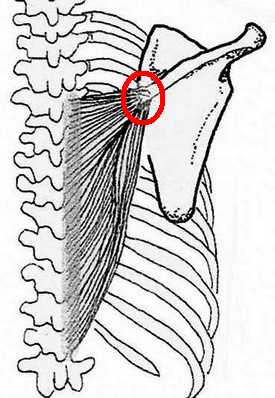Scapular depression is a small part of the lower traps. They also,
- Upwardly rotate the scapula
- Retract the scapula
Image found here. Unsure of original source.
Upward rotation tends to be hard for people to visualize:
GIF made from this video.
Lower trap:
Anatomy drawings are a little funny this way. Look at them enough, and you'll see inconsistencies in attachment points. To be fair to the artists, anatomy isn't all that consistent itself!
Point being, if you look at the red circle insertion point of the lower trap above, we can see with its medial (inside) attachment, when it pulls down the lateral side will go up. Ala: upward rotation.
We can also see pure scapular depression isn't going to be a big job of the lower trap. Because again, if it pulls down by itself, part of the scapula will actually move up.
Long story short- we don't really want to isolate a muscle in a vacuum of one action. We want to use the full breadth of its potential work.
So, when you mention doing dips and pull-ups, sure, there can be scapular depression at the top of those movements. However, there doesn't have to be. For instance, in pull-ups, at the bottom we start with the shoulders shrugged into the ears. Who says we can't be at the top of the rep that way?
A lot of people end their pull / chin-ups like above.
Next, even if we are hitting scapular depression in dips / pull-ups, we're not maximizing how much we can work the lower trap. There's no (active) upward rotation, and retraction is similar to depression- it may or may not happen. (Downward rotation will happen.)
To get all three actions, we should
- Raise the arms overhead (upward rotation)
- Once getting overhead, pull the arms back (retraction)
- Finally, end with a little pull down of the shoulders (depression)
This video is an example of trying to focus on the upper traps. The movement finishes at the top with a little extra elevation. If you did the opposite -some depression- you'd then shift focus more to the lower traps.
- https://www.youtube.com/watch?v=09jfP_lyT3A
Credit and more about arm raise variations.
Close up:
- https://www.youtube.com/watch?v=a5IcQX3P_Y0
The reason for standing with the back against the wall is it's super common to arch the lower back when raising the arms overhead. That is, a person will think they're getting the arms overhead, but really they're leaning back to get that positioning.
Notice how this person's hands are overhead,
But, that's because they're leaning back. In reality, their arms hands are not above their shoulders, but in front:
I bring this up because this is an extremely common pattern, particularly in males who lift a lot. Where overhead motion is often lacking. Bodybuilder types spend wayyy more time in the horizontal plane, and pulling their arms down, than they spend pushing their arms up.
One can view that as lower trap weakness being common, but that's fairly simplistic. Considerations like latissimus dorsi stiffness, upper trap weakness, and more need to be part of the picture.
One tangential note- the order of upward rotation, retraction, depression, is important. You do not want to say, attempt retraction, depression, then upward rotation. This is the common mantra of "Pull your shoulders back and down!" If you do this first, it's damn hard to get your arms up!
It's also a common impairment of those with shoulder pain. Where they lack upward rotation, retracting too soon, causing shoulder pain / discomfort. In my experience, overwhelmingly issues of the lower trap are with upward rotation. Not depression or retraction. That is, your average person with shoulder problems does not have problems pulling them down or together. They have problems raising them up.
Coming full circle to usefulness- that's fairly subjective. Most are going to say overhead range of motion is important to them. Somebody only concerned with hypertrophy for the time being? Maybe not.
That said, the lower traps rarely need dedicated work. For instance, overhead pressing will work them plenty. Many have a lot of scapular retraction work in their programs e.g. seated row, where the lower traps get worked a ton in that fashion.
If you're simply curious will targeting the lower traps lead to noticeable hypertrophy / performance improvements elsewhere, then unless one of those performance measures is shoulder health / overhead range of motion, probably not. It's not like how a bench presser might want extra tricep work.






